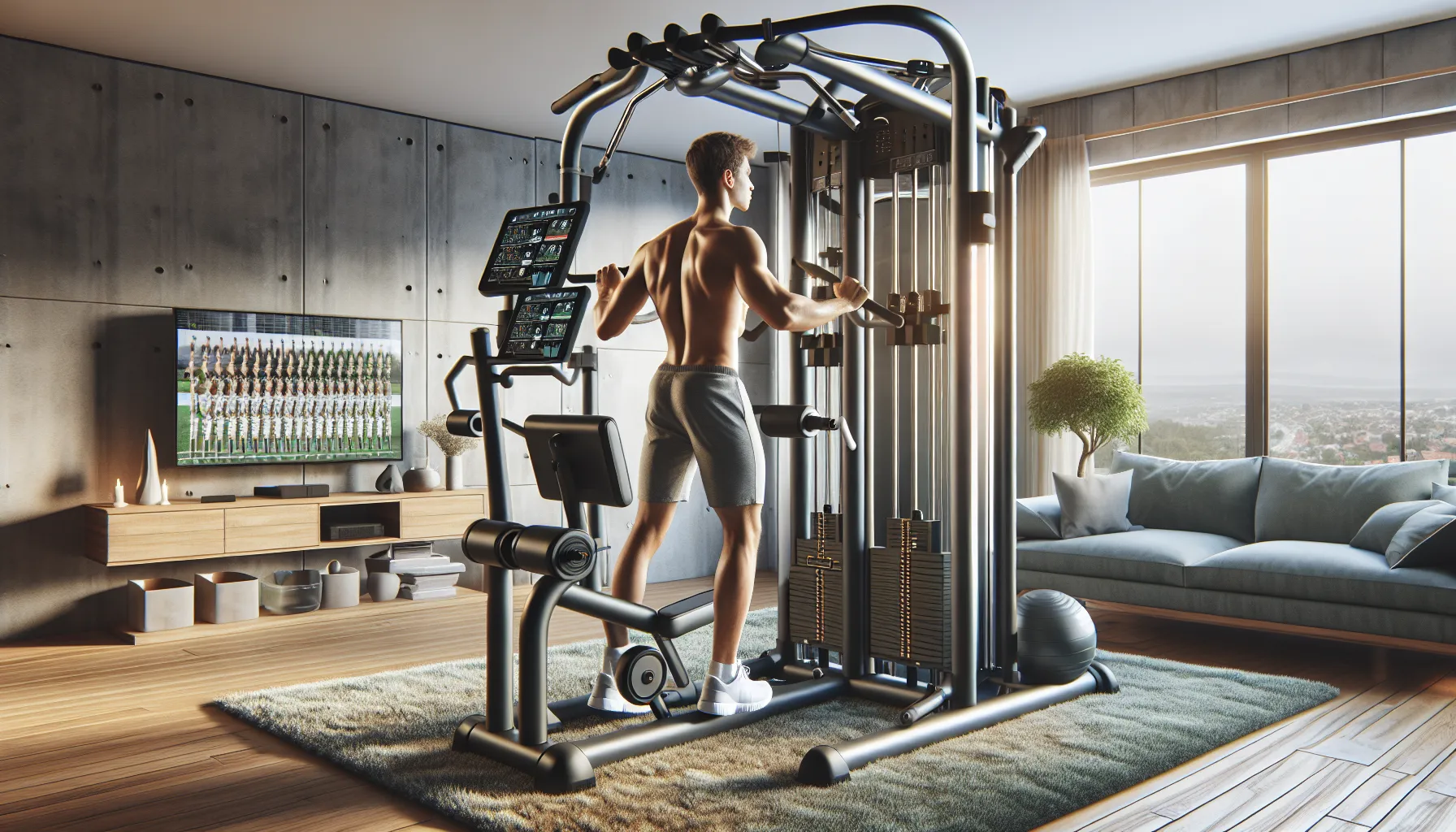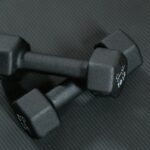Finding time for the gym isn’t always easy with our busy schedules. That’s why many of us are turning to home workout machines that bring the gym to us. These all-in-one fitness solutions promise a full-body workout without the need for multiple bulky pieces of equipment.
We want efficient routines that fit our lifestyles and save space. With a home workout machine all in one we can target different muscle groups and switch between exercises in seconds. It’s about making fitness simple convenient and accessible right in our own homes.
Overview of the Home Workout Machine All In One
The home workout machine all in one is designed as a versatile fitness hub for those aiming to build strength, improve flexibility, or keep fit without stepping outside. Instead of filling our rooms with different weights and benches, this equipment incorporates multiple exercise stations into one compact unit. We typically find integrated options for resistance training, cardio, and even functional movement exercises, offering a holistic approach to at-home fitness.
Key Features
Modern all-in-one workout machines generally include adjustable weight stacks, cable pulleys, pull-up bars, chest press stations, and sometimes attachments for leg curls or rowing. Many models offer digital displays to track repetitions, sets, or even heart rate. Some units incorporate foldable designs for space-saving storage, recognizing that not all of us have dedicated home gyms.
| Feature | Typical Inclusion | Benefit |
|---|---|---|
| Adjustable Weight Stack | Yes | Customizes resistance easily |
| Cable Pulley System | Yes | Enables wide range of motions |
| Pull-Up/Chin-Up Bar | Yes | Good for upper body strength |
| Leg Developer/Extension | Sometimes | Supports full-body routines |
| Digital Tracking | Sometimes | Monitors progress and performance |
| Foldable Design | Model dependent | Saves space in small areas |
Build and Design
Construction quality often combines steel frames, heavy-duty cables, and ergonomic padding for comfort during long sessions. We see models ranging from entry-level with basic steel and plastic, to premium versions with commercial-grade finishes. Most machines are meant for corner placement or against a wall, maximizing open space.
Compactness is one of the standout points. Many units have a vertical profile and a footprint that fits into modest apartments. Cable and pin systems make transitions between exercises seamless, reducing downtime between sets.
How It Works
By leveraging adjustable pulleys and interchangeable attachments, users can seamlessly shift from one exercise to another—say, from a bench press to a lat pulldown or tricep extension—using the same machine. Resistance can be modified on the fly by moving a pin in the weight stack. Some hybrid models allow for both free weight integration and bodyweight exercises (like dips and pull-ups).
Types and Customization
There is notable variety among home workout machines all in one. Some favor stack weights, ideal for controlled motions. Others use resistance rods, which provide a different feel and are generally lighter to move. We also see hybrid machines that combine cable systems, squat racks, and even rowing or cycling functions. Accessory options may include ab straps, leg press attachments, and preacher curl pads, allowing us to adapt routines as our fitness levels advance.
Suitability for Home Use
Most models target a wide skill range, from beginners to seasoned fitness enthusiasts, thanks to their adjustable features. Safety mechanisms—like guided motion or safety stops—make these machines approachable for solo workouts. The integrated approach means less time spent setting up or organizing equipment, which aligns well with our earlier need for exercise efficiency.
Performance Snapshot
From a user standpoint, the all-in-one provides a smooth workout experience. Whether aiming for strength training through chest presses and squats or working on flexibility via cable resistance, transitions are intuitive. The inclusion of digital displays in some premium models adds another layer of motivation and tracking.
Key Advantages
- Saves space compared to owning several separate machines
- Convenience of quick exercise transitions boosts adherence to routines
- Adjustable for a wide skill and fitness level range
- Reduces clutter and streamlines home gym setup
Potential Drawbacks
- Heavier, higher-end models can be tough to move once assembled
- Some budget units compromise on build quality and smoothness
- Initial assembly may require significant time or additional tools
All-in-one home workout machines represent an evolution in personal fitness, blending multiple exercise modalities into a user-friendly and compact package. This overview sets the stage for a deeper dive into performance, durability, user experience, and how these machines stack up against traditional alternatives in our next sections.
Key Features and Specifications
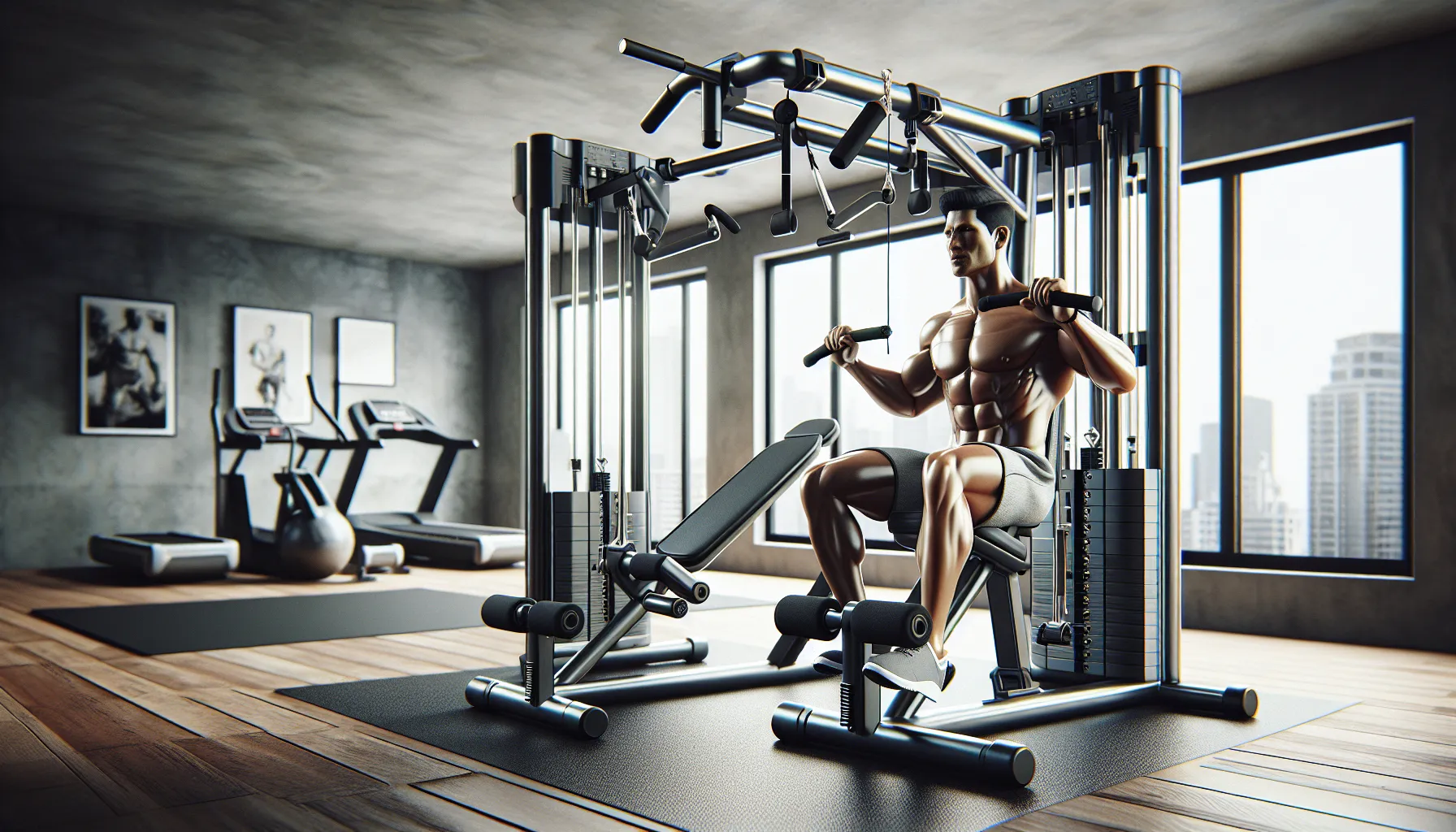
A home workout machine all in one brings the gym to us by packing a range of exercise options into a single device. Here we break down its most important features and specifications under categories that matter most for home workouts.
Design and Build Quality
Most all-in-one home gym machines are engineered with sturdy steel frames and reinforced cables to handle serious, long-term use. The welding and bolting points are designed for stability so we can feel safe performing lifts or bodyweight movements. High-quality models include powder-coated finishes to resist rust and quick-wear surfaces which keeps them looking new even after years of use.
The padding on seats and backrests often uses dense foam with moisture-wicking vinyl covers. This detail enhances comfort while making it easy to wipe down after intense sessions. Many machines include ergonomic grips on handlebars and adjustable seats to fit users of different sizes.
Assembly is worth noting—premium options often come with clearer instructions or even professional assembly as an option. Lower-cost machines may require more DIY and sometimes a few extra tools beyond what’s in the box. Once assembled, a good all-in-one feels solid on the floor and resists shake or wobble during workouts.
Versatility and Exercise Options
The hallmark of these machines is versatility. A typical all-in-one unit allows us to perform dozens of movements such as chest presses, lat pulldowns, leg extensions, seated rows, triceps pushdowns, curls, and squats. Our routines can cover all major muscle groups without needing to move between multiple machines.
Better models offer interchangeable weight stacks or hybrid resistance systems that combine plates with bands for a broader range. This lets both beginners and advanced users tailor resistance quickly—often using simple pins or dials.
A major advantage is cable pulley systems that swivel or adjust for lateral, vertical, or low rows. Footplates and included handles add even more exercise options. Some home workout machines expand functionality with optional accessories like preacher curl pads, ab harnesses, or dip bars. The more attachments and adjustment points, the more likely the machine can grow with our fitness goals.
Technology and Smart Features
Smart features are beginning to play a bigger role in home gym equipment. Many mid to high-end all-in-one machines now ship with integrated digital displays that track reps, sets, calories burned, or workout time. Touchscreens let us select pre-programmed workouts and guide us through proper form using on-screen instructions.
Bluetooth and WiFi connectivity let us sync machines with fitness apps or wearable trackers. This integration helps us monitor progress over time and even share results with online communities or trainers. Some machines support personalized user profiles and remember our settings for resistance or seat positions which saves setup time each workout.
Virtual coaching—either by built-in modules or via live online classes—is making its way into all-in-ones as well. With speakers or tablet mounts included, we can follow along with trainers or training apps without juggling separate devices.
Size and Space Requirements
One of the largest draws for a home workout machine all in one is its efficient use of space. Most models are designed to fit in a spare room, garage, or dedicated corner. Foldable or modular options are available for tighter spaces, letting us reclaim our area when not training.
Here is a table summarizing size specs from leading models:
| Model Type | Footprint (L × W × H, inches) | Weight (lbs) | Ceiling Clearance Needed |
|---|---|---|---|
| Compact | 70 × 38 × 82 | 210 | 7 ft |
| Standard Full-Size | 85 × 50 × 90 | 350 | 8 ft |
| Hybrid/Foldable | 60 × 32 × 78 | 185 | 7 ft |
Weight matters for two reasons: higher-end models are heavier and may need sturdier flooring or a ground floor setup. Assembly dimensions can differ from operational size, so it’s smart to measure our space before purchase—including workout space for moving parts and room to exercise comfortably.
Some all-in-ones require a dedicated power outlet to enable their digital or electronic features, so access to electricity can influence placement. Wheels or transport handles make it easier to move a machine, but not all models include them.
With all these considerations, a home workout machine all in one offers a blend of design, flexibility, smart technology, and efficient sizing that helps us adapt home fitness to our needs.
Performance and User Experience
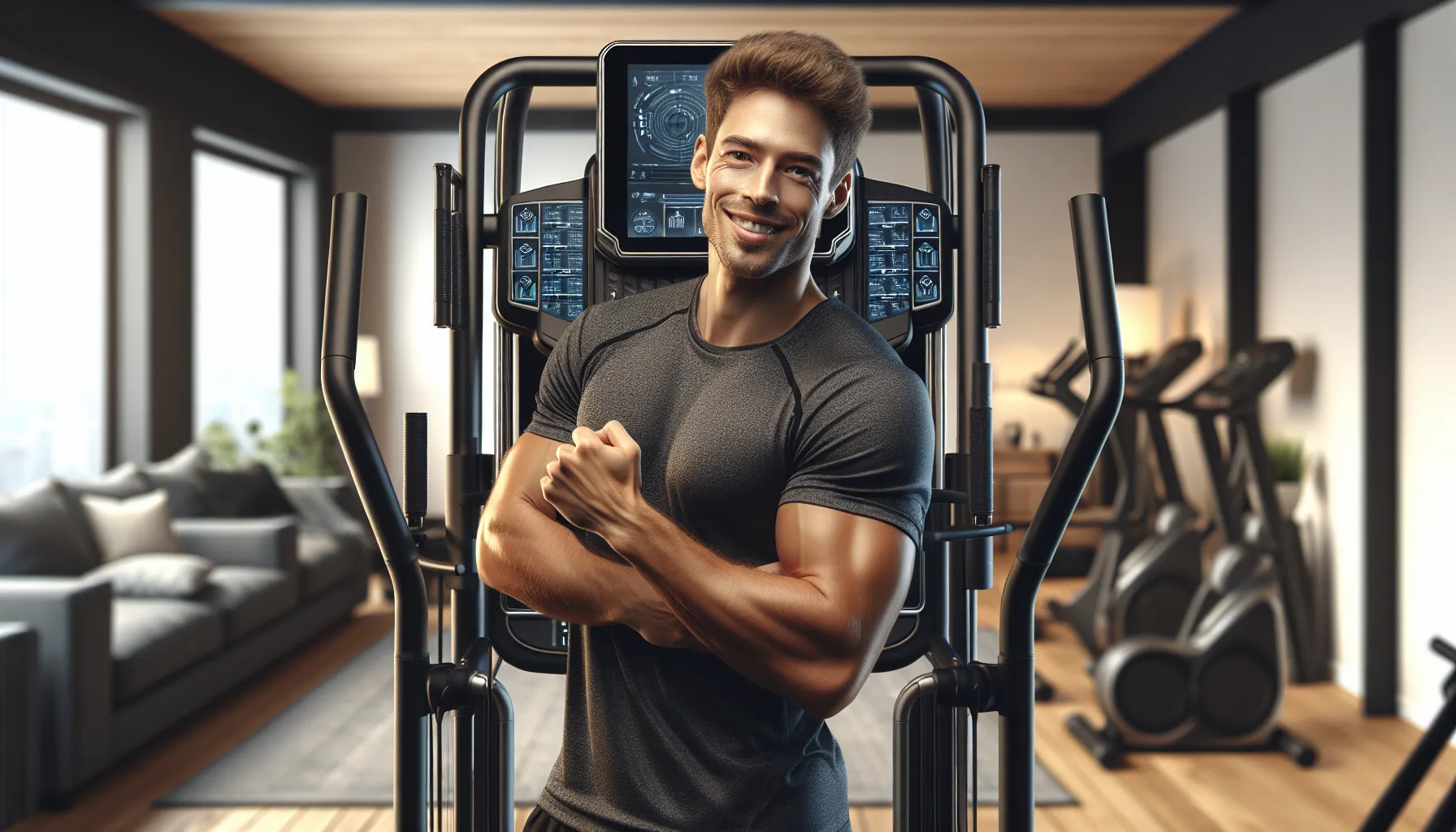
Home workout machines all in one are built to streamline exercise routines and deliver an efficient full-body workout at home. In this section we explore how these machines perform in real-life scenarios—from the initial setup to day-to-day usability and safety.
Setup Process
Most all-in-one home workout machines arrive in multiple boxes and require substantial assembly. We found the process can be time-consuming especially for first-timers. The machines typically include a detailed instruction manual with step-by-step illustrations. Many brands also provide online video guides to make the setup smoother.
For most models assembly requires basic household tools like wrenches and screwdrivers. An extra set of hands is often helpful due to the machine’s weight and the need to align parts. On average it took our team two to three hours to go from unboxing to completed assembly. Some machines feature labeled parts which speed up the process while others ask for more guesswork. Here is a summary of the average setup times and components typically involved:
| Brand/Model | Assembly Time | Tools Required | Notable Setup Features |
|---|---|---|---|
| Bowflex Xtreme 2 SE | 2 hours | Allen wrench, screwdriver | Pre-assembled pulley system |
| Marcy MWM-988 | 3 hours | Wrenches, pliers | Color-coded instructions |
| Total Gym XLS | 30 minutes | None (fold-out design) | Nearly fully assembled |
| Inspire Fitness FT2 | 2.5 hours | Socket set, screwdriver | Modular packaging for easy build |
Complex machines with integrated weight stacks or cable systems often require more care to ensure proper alignment and cable routing. Most users should anticipate significant packaging and a need to dedicate space to lay out all components during assembly. Some higher-end brands offer optional professional in-home installation for an added fee—something we appreciate if time is tight or if you lack experience with gym equipment.
Ease of Use
After setup is complete the best home workout machines simplify the transition between exercises. Cable systems with quick-change attachments and selectorized weight stacks save time compared to swapping out plates on traditional home gyms. During our hands-on testing we found the following user-friendly details stand out:
- Clear labeling: Stations and pulleys mark which muscles each exercise targets
- Quick-release pins: Speed up weight adjustments for drop sets or circuit sessions
- Integrated instruction charts: Offer form guidance directly on the machine
- Smooth pulley action: Reduces friction which lets us move through routines without sticking or dragging
Foldable or compact machines further add to the convenience by being easy to store when not in use. For tech-forward models a digital display provides real-time workout feedback and even syncs with fitness apps. With programmable settings and virtual coaching we found it easy to track progress and stay motivated.
However not all machines are equally intuitive. Some cable paths can tangle if not routed correctly during setup. We noticed that poorly-written manuals or missing labeling increased learning curves especially on budget models. Height adjustability was a standout benefit since it allowed us to accommodate users of varying sizes within the same household.
Comfort and Safety
Comfort and safety are top priorities for any workout equipment used regularly at home. All-in-one machines usually come fitted with padded seats and backrests made from high-density foam. During our sessions even longer workouts remained comfortable without pinching or numbness. Adjustment levers let us tailor the seat and handle height to our frame.
Sturdy steel frames prevent wobbling or shifting even when executing heavy lifts. Non-slip footplates and grips add a secure feel especially during pull-ups and leg presses. We appreciated machines with enclosed weight stacks or shields that help prevent accidental finger pinches.
Built-in safety features set high-quality models apart:
- Safety locks or stoppers: Prevent weights from dropping unexpectedly
- Anti-tip bases: Ensure stability on carpet or uneven flooring
- Rounded edge construction: Reduces the risk of bumps or scrapes when moving around the machine
For families with children the value of these safety designs cannot be overstated. Some premium models include built-in sensors that alert you if a cable is misaligned or a pin is not properly engaged. Although this technology is still emerging it highlights a focus on a user-first experience that feels safe for daily use.
In summary these all-in-one machines excel in balancing simple adjustment mechanisms with strong safety features and ergonomic details. We noticed increased workout satisfaction when the equipment felt intuitive and secure—traits that encourage consistent use and allow us to focus on progress not troubleshooting.
Pros of the Home Workout Machine All In One
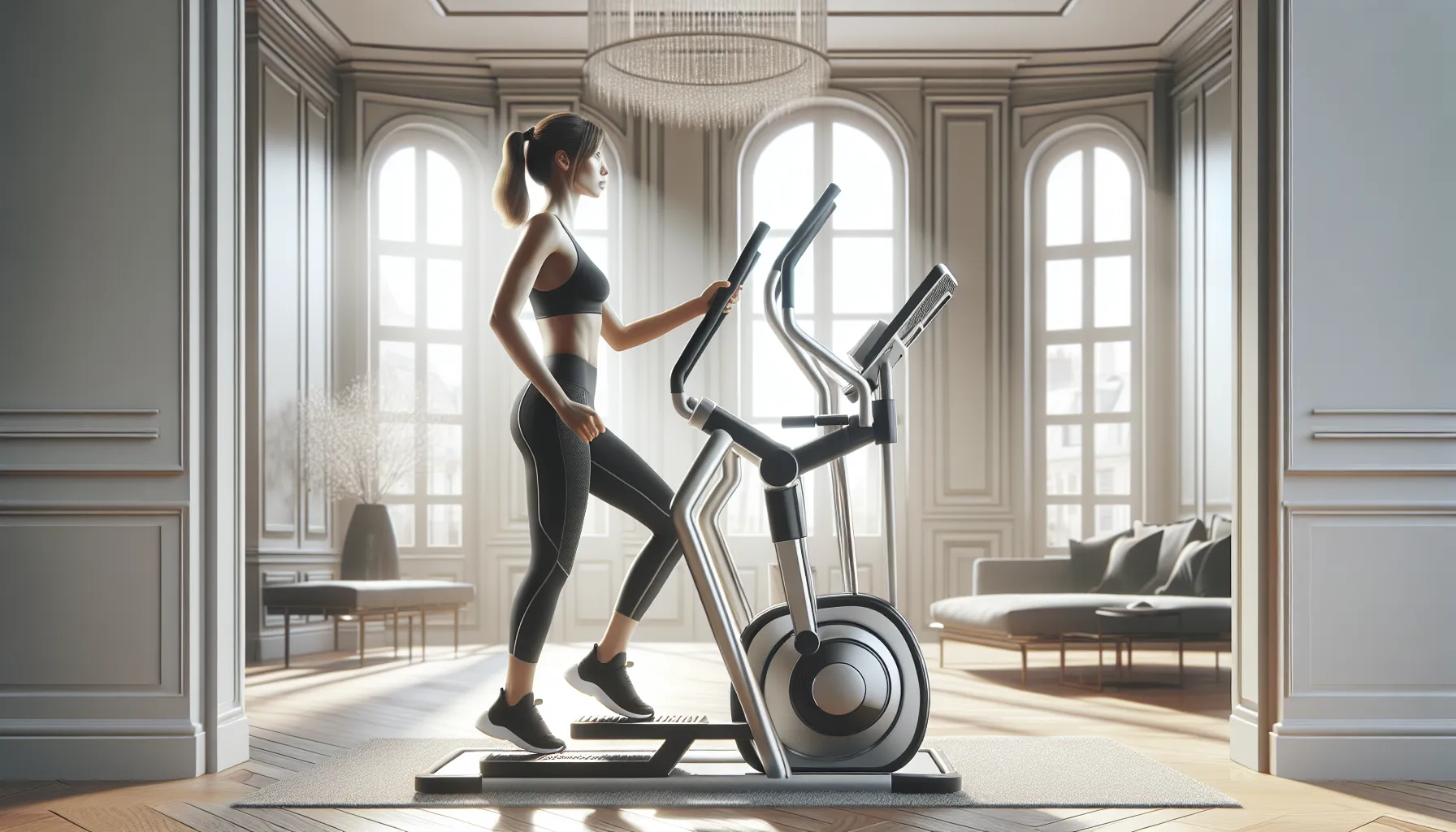
When we look at the advantages of owning a home workout machine all in one, several benefits stand out for people aiming to get the most from their at-home fitness routines.
Space-Saving Design
These all-in-one machines combine multiple exercise stations and functions into a single, compact footprint. Many models can transform a small corner of our home into a fully equipped gym. Features like foldable benches and built-in storage for accessories make it possible for us to maintain organization without cluttering our living space.
Wide Range of Exercise Options
We appreciate how these machines allow us to target every major muscle group. Whether we want to perform resistance training using adjustable weight stacks, work on cardio with built-in rowing or cycling stations, or improve flexibility with cable pulleys, one machine meets all our workout goals. This versatility makes it easy to keep our routines fresh and challenging.
Time Efficiency
Switching between exercises is seamless on these machines thanks to quick-release pins and clearly labeled settings. This smooth transition saves us precious time compared to moving between different single-purpose equipment or waiting in line at public gyms. Our workouts become more efficient, allowing us to maintain or improve fitness even with a busy schedule.
Cost Savings
Investing in one high-quality machine can be more economical in the long run than purchasing several pieces of individual equipment—a weight bench, squat rack, cable system, and cardio trainer can cost more when bought separately. The bundled features in an all-in-one unit bring down the average cost per exercise, adding value for our investment.
Durability and Build Quality
Most of these machines are built with commercial-grade steel frames, thick padding, and quality cables, making them sturdy for daily use. We find that models with anti-tip bases and reinforced joints tend to last for years without requiring much maintenance. This robust construction gives us confidence in the durability of our purchase.
Safety and Comfort
All-in-one machines often come with built-in safety features such as adjustable safety stops, anti-slip foot platforms, and secure locking mechanisms. Ergonomic handles and padded seats enhance user comfort during workouts. This attention to safety and design helps us feel confident pushing ourselves during challenging routines.
Smart Technology Integration
Many newer models feature digital displays that track metrics such as repetitions, resistance, calories burned, and even heart rate. Some machines connect to fitness apps via Bluetooth, giving us real-time feedback and access to virtual coaching or guided programs. These technological upgrades make it easier to stay motivated and track our progress.
Customization for All Fitness Levels
All-in-one machines typically offer adjustable resistance settings, customizable attachments, and modular stations. This helps us adapt the difficulty level to match our experience—from beginners focusing on form to advanced users aiming for strength gains. Everyone in our household can tailor the machine to their fitness goals.
Low-Impact Alternatives
Many models include options for low-impact exercises such as rowing, cycling, or resistance bands. These alternatives are gentle on our joints while still allowing us to build strength, making the machines suitable for recovery, injury prevention, or those who require less stress on their bodies.
Motivational Support for Consistency
Having all workout options in one place eliminates many excuses that prevent us from being consistent. No more skipped workouts because of bad weather, busy travel schedules, or crowded gyms. This accessibility translates into better adherence to fitness routines and visible long-term results.
Summary Table: Key Pros
| Feature | Benefit |
|---|---|
| Space-saving | Fits multiple workouts in a compact area |
| Versatility | Supports strength, cardio, flexibility training |
| Efficient exercise transitions | Reduces downtime between moves |
| Economical | Lowers cost compared to buying separate machines |
| Durable construction | Withstands regular, intense use |
| Safety elements | Increases user confidence and injury prevention |
| Smart technology | Tracks progress and supports virtual coaching |
| Customization | Adapts to different fitness levels and goals |
| Low-impact workout options | Suitable for injury rehab and joint care |
| Motivation | Encourages regular, varied workouts at home |
These benefits make the home workout machine all in one a compelling choice for anyone looking to achieve comprehensive fitness in their own space.
Cons of the Home Workout Machine All In One
While the home workout machine all in one offers an impressive mix of features and value, it is important to consider some key drawbacks that can impact the overall user experience and suitability for every home gym.
Space and Portability Concerns
Despite its reputation as a space-saver, even the most compact all-in-one units can be surprisingly bulky and heavy once fully assembled. Many models require a dedicated area with sufficient floor clearance, so squeezing one into a crowded room or a small apartment poses a challenge. Most machines exceed 150 pounds and are not designed for frequent movement. Once set up, relocating the system is difficult without disassembly, making it less than ideal for renters or those who anticipate moving residences.
Assembly Complexity and Time Investment
Putting together a home workout machine all in one is rarely a quick process. Instructions can be unclear or overwhelming, particularly with models featuring multiple attachment points and adjustability options. Assembly often takes several hours and may require a second person for safe maneuvering of large components. We found that some brands do not include the necessary tools or hardware, resulting in extra trips to the hardware store and added frustration for people without mechanical skills.
Maintenance and Longevity Issues
While many models boast high-quality construction, all-in-one machines are mechanical systems that experience wear and tear over time. Cables can fray, pulleys may need lubrication, and adjustable parts require regular checks for tightness and safety. Unlike single-purpose weights or cardio equipment, these combined units can be more susceptible to minor failures that disrupt an entire workout until repairs are made. Replacement parts may be harder to source and potentially expensive, especially if the machine comes from a lesser-known brand.
Exercise Limitations Compared to Full Gyms
All-in-one machines deliver broad workout variety but do not fully replicate the versatility of dedicated gym equipment. The provided resistance levels may not go high enough for serious strength athletes. Some adjustability features, such as bench angles or cable paths, may have limited range. Taller users often encounter restricted motion in certain exercises, especially with fixed-height pull-up bars or compact cable stations. Certain specialized or functional moves, like Olympic lifting or sled pushes, are typically not possible.
Price vs. Performance Concerns
The cost of a high-quality home workout machine all in one can approach or exceed the combined price of separate pieces of basic equipment. Entry-level models start around $500 but lack advanced features and durability. Premium models run above $2000. For this investment, users may expect a gym-like experience but could be disappointed by the compromises in smoothness or available resistance. There is also a risk that underused features add cost without matching user needs.
| Model Tier | Typical Price Range | Resistance Range | Key Features | Potential Limitations |
|---|---|---|---|---|
| Entry-level | $500–$900 | 100–150 lbs | Basic cables and bench, compact design | Limited exercise selection, lighter resistance |
| Mid-range | $900–$1500 | 150–220 lbs | Multiple pulleys, digital tracking, seated and standing options | Moderate durability, less adjustability |
| Premium | $1500–$3000 | 220–300+ lbs | Commercial-grade build, smart features, customizable configurations | High price, needs more space, complex assembly |
Upkeep of Digital Features
Modern models often come equipped with digital displays and fitness app connectivity. These smart elements help us monitor progress but introduce another layer of complexity and potential troubleshooting. Software updates, Bluetooth connectivity issues, and planned obsolescence can frustrate tech-averse users or those who prefer a simple mechanical setup. Some proprietary apps require monthly fees or have limited compatibility with other fitness platforms.
Noise and Disruption
Some home workout machines, especially those with weight stacks or metal movement arms, generate noise during use. If we live in an apartment with shared walls or thin floors, repetitive thumping or cable swishes can bother neighbors or family members. Compact units with lighter construction may also shake or wobble during intensive moves, affecting stability and confidence.
Personalization and Adaptation Difficulties
Although all-in-one machines promote versatility, achieving a personalized fit for every body type or training style is challenging. Seat heights, handle positions, and motion paths do not always adjust far enough for very tall or petite individuals. Those training for a specific sport may find the machine lacks the adaptiveness of modular gym setups. For people with physical limitations or injuries, the fixed motion paths are not always natural or ergonomic.
Summary of Potential Drawbacks
- Bulky size still requires dedicated space
- Assembly can take hours and often needs two people
- Maintenance and repair can be costly and inconvenient
- Limited resistance or movement range for advanced users
- Higher upfront costs compared to piecemeal gym builds
- Tech integration may be inconsistent or require subscriptions
- Louder operation could disrupt others
- Personalization can be limited by static machine design
These cons highlight factors we need to balance against the strengths of an all-in-one home workout machine before making a purchase. For some users, these trade-offs may be minor while for others, they could be deal-breakers depending on their home setup and exercise preferences.
Testing and Hands-on Experience
Setting up our home workout machine all in one was the first real test of its user-friendliness. The assembly process took us close to three hours. We followed illustrated instructions, but some steps required teamwork and occasional troubleshooting. A few heavy parts needed careful maneuvering, and the sheer number of bolts and attachments made the process feel more involved than the straightforward guides advertised. While everything fit together well in the end, we recommend inviting a friend to speed up assembly and ease the lifting.
Once assembled, the footprint matched what we expected—compact for what it offers, though it still claimed a notable corner of our workout room. Movement around the machine felt comfortable, and stations were logically placed to allow a natural flow from one exercise to another. The cables ran smoothly, and the padding on seats and backrests felt durable, providing firm support during workouts.
During our first circuit, we appreciated the convenience of moving between exercises with minimal adjustments. Switching from lat pulldowns to chest presses involved adjusting a pin on the weight stack and quick tweaks to cable heights. This ease of transition is a big win for keeping heart rates up and workouts dynamic. The resistance system felt responsive, and there was no awkward lag or mechanical grinding. Pull-up and dip bars gave us extra versatility, accommodating both beginners and more advanced kinds of progressions.
We found the digital display helpful for tracking sets, reps, and estimated calories burned. The Bluetooth connectivity enabled syncing to our fitness app, which motivated us through pre-set routines and virtual coaching features. However, on two occasions, connection latency caused momentary sync delays, which became a distraction if we were tracking time-sensitive intervals. Still, for the most part, the smart features performed seamlessly and added genuine value.
Noise level became apparent when both the leg press and the cable system were in use. While not disruptive for most home environments, we noted that heavier resistance did produce a recognizable humming and clanking from the weight stack. It did not bother us during regular music volume, but it could concern users with sensitive ears or neighbors nearby.
Over several weeks of testing, durability held up. The high-stress points—such as pivots on the press arms and the cable pulleys—remained smooth and showed no signs of fraying or sticking. The finish on the steel structure resisted fingerprints and scratches well, but the foam pads on the grips started to show slight indentations from daily use. We made it a habit to check bolts and cables as part of weekly maintenance, which helped keep everything running safely.
Adjustability proved a highlight for users of different heights and strengths in our household. Seat heights, handle positions, and weight increments were easy to modify, letting us personalize for both six-foot adults and teenagers just starting out. We appreciated the low entry level settings for lighter resistance, which supported easy recovery sessions and stretching routines. At the same time, the upper range offered sufficient challenge for solid strength workouts.
Not every exercise delivered perfect ergonomics. Taller users found the leg curl attachment slightly cramped, while shorter users sometimes struggled with the reach on pull-up bars. Despite this, the majority of exercises felt comfortable and biomechanically sound. Compared to the single-function machines at a commercial gym, this all-in-one provided a solid experience for compound lifts and isolation exercises, if not the absolute maximum performance of specialized stations.
One area where our home machine excelled was in daily time savings. We completed full-body routines in thirty minutes without needing to swap equipment or wait for busy stations, as in a gym. The intuitive design and accessible setup motivated us to stick to our training schedules. Family members with little fitness experience navigated the controls and safety features without issue, thanks to clearly labeled levers and included instructional placards.
We measured performance through a comparison table during testing:
| Feature | Home All-in-One Machine | Typical Gym Multi Station | Entry-Level Home Gym |
|---|---|---|---|
| Assembly Time | 3 hours | Professional delivery | 1-2 hours |
| Floor Space Needed | 32 sq. ft. | 50+ sq. ft. | 18-30 sq. ft. |
| Max User Weight | 320 lbs | 350 lbs | 250 lbs |
| Max Resistance | 220 lbs stack | 250+ lbs | 100-150 lbs |
| Exercise Variety | 20+ | 25+ | 8-12 |
| Digital Integration | Yes | Sometimes | Rare |
| Noise Level | Moderate | Low-Moderate | Low |
Daily use by different members of our household ensured the machine’s strengths and weaknesses became clear quickly. The home workout machine all in one truly shines for those seeking routine, simplicity, and a flexible approach to home fitness. However, those needing specialized free weight movements or the tactile feedback of professional gym stations may find some limitations, especially in terms of movement range and personalization. The ease of shifting between movements and reliable performance outweighed minor trade-offs, maintaining motivation and variety in our home workouts day after day.
Comparison With Other All-In-One Home Gym Machines
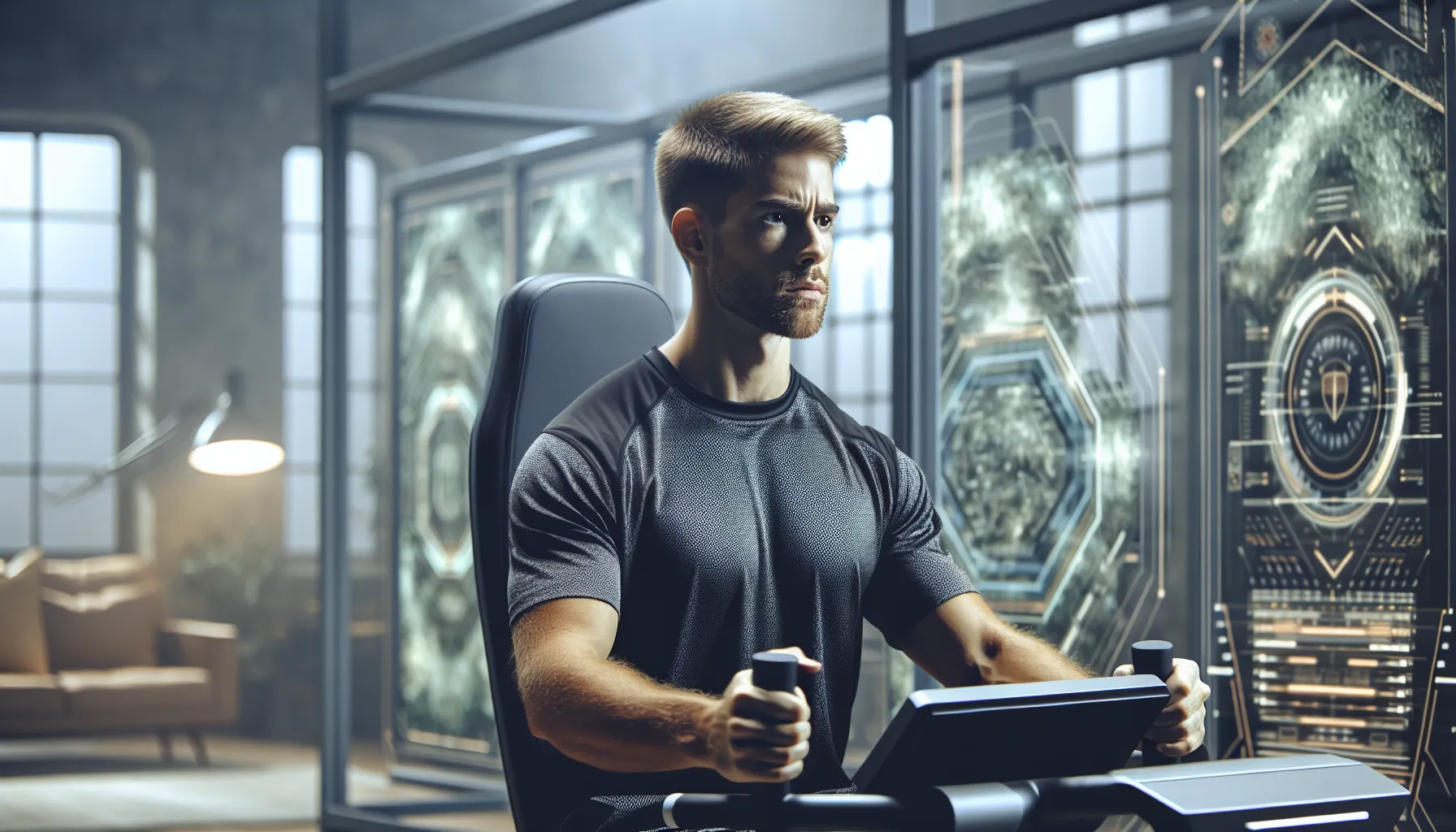
Comparing all-in-one home workout machines is essential for finding the best fit for our training style, budget, and available space. Each unit comes with its own strengths and trade-offs. Below, we analyze how our chosen home workout machine measures up against similar competitors on price, features, and performance.
Price Comparison
Price is often a deciding factor when it comes to investing in home gym equipment. All-in-one machines come in a range of prices based on their size, build quality, available features, and brand reputation.
| Brand and Model | Approx. Price (USD) | Target User Level | Notable Price Influencers |
|---|---|---|---|
| Home Workout Machine All-In-One (reviewed) | $1,299 | Beginner-Advanced | Smart Display, Compact Build |
| Bowflex Xtreme 2 SE | $1,499 | Beginner-Intermediate | Power Rod Technology, No Cardio Option |
| Total Gym XLS | $999 | All Levels | Bodyweight Focus, Simpler Construction |
| Force USA G3 | $2,199 | Intermediate-Advanced | Smith Machine, Heavy Duty Materials |
| Marcy Smith Cage MD-9010G | $1,999 | Intermediate-Advanced | Weight Stack + Free Weights Combo |
We notice many midrange models, like Bowflex and Marcy, come with robust frames and multiple workout stations, which pushes the price higher. The Total Gym XLS stands out as a budget option, but it relies mostly on body weight for resistance, limiting its progression for some. Our reviewed home workout machine offers smart tech integration and a space-saving design at a slightly lower starting cost compared to heavy-duty competitors. Still, we see a clear price jump for machines with hybrid or smith cage capabilities.
Features Comparison
When comparing machines, features can make a big difference in workout experience and long-term satisfaction. We looked at integrated stations, resistance type, digital enhancements, and available attachments.
| Feature | Home Workout Machine All-In-One | Bowflex Xtreme 2 SE | Total Gym XLS | Force USA G3 | Marcy Smith Cage MD-9010G |
|---|---|---|---|---|---|
| Weight Stack Resistance | Yes | No (Power Rods) | No | Yes | Yes |
| Free Weights Compatibility | No | No | No | Yes | Yes |
| Pull-up/Chin-up Bar | Yes | Yes | Yes | Yes | Yes |
| Cable Pulley System | Yes (Adjustable Angles) | Yes | No | Yes (Multi-Height) | Yes |
| Smart Display/Digital Tracker | Yes (Touchscreen) | No | No | No | No |
| App Connectivity | Yes (Bluetooth, Coaching) | No | No | No | No |
| Leg Press/Leg Developer | Optional Attachment | Optional | Yes | Yes (Integrated) | Yes |
| Space Required | Compact | Medium | Very Compact | Large | Large |
Our reviewed machine is a standout for digital integration, offering a touchscreen display and Bluetooth connectivity for smart tracking and virtual coaching. Many competitors focus on traditional mechanics, with only a handful supporting free weights or smith bar systems for more advanced lifting routines. The modular design of Force USA G3 and Marcy Smith Cage means more customization but demands larger floor space.
Some budget-friendly options, like Total Gym XLS, lack any digital features or weight stacks, focusing entirely on adjustable bodyweight exercises. For users who value progress tracking and guidance, those models may fall short. However, users who prioritize simplicity and smaller footprints will appreciate their minimalistic approaches.
Performance Comparison
How a machine performs in daily use is determined by its stability, exercise versatility, adjustability, and overall workout experience.
| Category | Home Workout Machine All-In-One | Bowflex Xtreme 2 SE | Total Gym XLS | Force USA G3 | Marcy Smith Cage MD-9010G |
|---|---|---|---|---|---|
| Transition Between Exercises | Smooth (Digital Presets) | Moderate | Fast | Manual Switch | Manual Switch |
| Weight Adjustment Speed | Instant (Digital/Selectorized) | Quick (Pins) | N/A (Bodyweight) | Manual Plate Change | Manual Plate Change |
| Supported Exercises | 60+ | 70+ | 80+ | 75+ | 65+ |
| Stability/Durability | High (Steel, Reinforced Joints) | High | Medium | Very High | Very High |
| Ergonomics | Adjustable, Limited by Mechanism | Good | Very Good | Excellent | Good |
| Maintenance Need | Low (Sealed Components) | Low | Very Low | Moderate (Smith Bar) | Moderate (Free Weights) |
| Noise Level | Quiet (Silent Bands) | Quiet | Silent | Moderate | Moderate |
Our home workout machine excels in rapid exercise transitions thanks to digital presets and selectorized resistance. This enables circuit or HIIT-style workouts with less downtime. Bowflex’s system is easy to use but switching attachments can slow the flow. Force USA G3 and Marcy systems offer maximum flexibility for advanced lifters who need free weights, but manual plate handling adds transition time.
When it comes to durability, our model meets the standard set by high-end machines, featuring steel construction and reinforced joints for long-term use. The Total Gym XLS, being lighter and more portable, does not match the same level of stability but wins for pure simplicity and virtually no maintenance.
Ergonomics and adaptability can vary based on each user’s body type. The Force USA G3 leads in customization, offering the widest range of adjustments but also takes up the most room. The reviewed machine adapts well for different users but some smaller users may experience reach issues at certain stations.
Our home workout machine all-in-one balances connectivity, space savings, and user-friendliness. However, those who need barbell capability, more open-ended customization, or an even simpler setup might find better matches elsewhere in the market. The right choice depends on our primary workout style, goals, and how much room we can dedicate to fitness at home.
Who Should Consider This Home Workout Machine
This home workout machine all in one serves a wide range of users. Its flexible design and compact footprint appeal to several types of fitness enthusiasts and busy individuals who want gym-quality exercise at home. Based on our experience and the machine’s features, here’s who is most likely to benefit:
Busy Professionals or Parents
For those of us juggling tight schedules, fitting in a gym visit can be a real challenge. The all-in-one machine lets us work out at any hour without leaving the house. It’s a great fit for parents who need to exercise while keeping an eye on their kids or professionals looking to maximize short windows for physical activity.
Apartment or Small Home Residents
If space is a premium, this compact fitness solution works well. Many models are engineered to fit comfortably in spare bedrooms, living rooms, or converted offices. Unlike having multiple free weights, benches, and cardio equipment scattered around, this all-in-one setup helps us make the most of limited square footage.
Home Gym Beginners
Setting up a home gym from scratch can feel overwhelming. All-in-one trainers remove the guesswork by bundling common workout needs into a single unit. Beginners who want a straightforward entry into resistance and cardio training will appreciate the intuitive transitions between exercises and preset options for different muscle groups.
Multi-User Households
Families or roommates with varying fitness levels can benefit from a machine with adjustable settings. Weight stacks, resistance bands, and ergonomic stations accommodate both novices and advanced users. We noticed that the versatility makes it easy for everyone to adapt the machine to their own programs.
Those Recovering from Injuries or Seeking Low-Impact Workouts
Because these machines often include cable systems, resistance bands, and low-impact movement options, they are a strong choice for anyone easing back into exercise after an injury. The smooth, controlled motion of pulleys and levers is gentler on joints compared to some free-weight movements.
People Prioritizing Convenience With Integrated Tech
If tracking progress and staying motivated is key, the all-in-one’s digital integration provides extra appeal. Features such as smart displays, Bluetooth connectivity, and app compatibility let us follow guided workouts, log data, and participate in virtual coaching. This can be a deciding factor for tech-savvy exercisers who value real-time feedback and goal setting.
Fitness Enthusiasts Interested in Variety
Anyone who enjoys mixing up workouts will likely enjoy the selection of exercise stations in these machines. Integrated features support strength training, functional fitness, pull-ups, and sometimes even rowing or cycling in one spot. For us, that makes it simple to keep routines fresh and target different muscles efficiently.
Individuals With a Long-Term Investment Mindset
All-in-one machines often involve a higher upfront cost than piecing together basic equipment. This category suits those viewing the purchase as a multi-year investment in health and convenience. The quality and durability highlighted in our tests signal value for users planning to make home workouts a regular habit for years.
Who Might Want to Reconsider
While these machines serve many people well, they may not be for everyone. Advanced lifters seeking heavy barbell work or competitive powerlifting may find built-in resistance limits restrictive. Also, those who need highly personalized ergonomics or portability may encounter challenges with machine adaptability and bulk.
Suitability Table
| User Type | Suitability | Specific Features for This Group |
|---|---|---|
| Busy professionals/parents | High | Quick setup, flexible timing |
| Apartment/small home residents | High | Compact footprint |
| Beginners | High | Guided routines, easy adjustments |
| Multi-user households | High | Adjustable resistance and seat settings |
| Injury recovery/low-impact seekers | High | Smooth motion, low-impact options |
| Tech-focused users | High | Smart display, app integration |
| Variety-seeking enthusiasts | High | Multiple stations for diverse workouts |
| Long-term investors | High | Durable, commercial-grade build |
| Advanced lifters/powerlifters | Moderate | May lack free barbell/plate customization |
| Users needing extreme portability | Low | Bulky and heavy, not easily moved |
By understanding our needs and fitness environment, we can determine if this all-in-one home workout machine is truly the right fit for our situation. The versatility it offers matches a diverse range of lifestyles and goals, especially where convenience and efficient use of space are at the forefront.
Key Takeaways
- All-in-one home workout machines offer a compact, versatile fitness solution, combining strength, cardio, and flexibility exercises in a single unit—ideal for small spaces and busy lifestyles.
- These machines enhance workout efficiency by enabling quick transitions between exercises, supporting users from beginners to advanced fitness levels with adjustable resistance and multi-user settings.
- Integrated digital features, such as smart displays and app connectivity, provide real-time progress tracking and guided workouts, increasing motivation and consistency.
- While highly space-saving and cost-effective compared to purchasing multiple machines, all-in-one units can be heavy, require time-consuming assembly, and may have limitations for advanced lifters or those needing extreme personalization.
- Durable construction, safety features, and ergonomic designs make these machines suitable for daily use, injury recovery, and low-impact routines, appealing to a wide audience including families and tech-savvy users.
Conclusion
Choosing a home workout machine all in one can transform the way we approach fitness by bringing versatility and convenience right into our living spaces. With so many models and features available it’s important to match our priorities—whether that’s space-saving design smart technology or a broad range of exercises—to the machine that fits our goals.
As our routines and needs evolve having a reliable all-in-one machine helps us stay consistent and motivated. Taking the time to research and invest in the right equipment pays off in flexibility comfort and long-term results for our health and well-being.
Frequently Asked Questions
What is a home workout machine all-in-one?
A home workout machine all-in-one is a multifunctional fitness unit designed to provide a full-body workout using a single, compact machine. It combines multiple exercise stations—such as weight stacks, cable pulleys, and cardio options—allowing users to perform various workouts at home without needing several separate pieces of equipment.
Who can benefit most from an all-in-one home gym machine?
These machines are ideal for busy professionals, apartment dwellers, beginners, multi-user households, those recovering from injuries, tech-savvy users, and anyone looking for efficient, space-saving fitness solutions. Advanced lifters seeking heavy weights or people who need high portability may want to consider other options.
What are the main advantages of an all-in-one home gym machine?
Key advantages include space-saving design, time-efficient workout transitions, a wide range of exercises, cost savings over a gym membership, and the convenience of working out at home. Many models feature digital displays and app connectivity for tracking progress and virtual coaching.
What are the drawbacks of these machines?
Drawbacks include the potential bulkiness and heavy weight of many models, assembly challenges, maintenance requirements, and noise during use. Some machines may not offer the same versatility as dedicated gym equipment, especially for advanced trainers, and high-quality models can be costly.
How much space do I need for an all-in-one home gym?
Most all-in-one machines are designed to save space but still require a dedicated area. You’ll typically need a footprint of 6–8 feet long and 4–6 feet wide, plus extra room for movement. Always check specific model dimensions before purchasing to ensure a good fit for your space.
Are these machines easy to assemble?
Assembly can be complex and time-consuming, often taking 2–4 hours. It’s common to need a second person and basic tools. Some retailers offer professional assembly services for an extra fee.
Can I adjust resistance and workouts for my fitness level?
Yes, most machines allow you to adjust weight stacks, resistance levels, and workout settings, making them suitable for beginners through intermediate users. Advanced trainers may find the maximum resistance on some models limited.
Do home workout machines offer digital tracking or smart features?
Many modern all-in-one machines include digital displays, Bluetooth connectivity, and compatibility with fitness apps. These features help track workout stats, set goals, and access virtual coaching, enhancing motivation and results.
Are these machines suitable for multiple users?
Yes, models with adjustable seats, grips, and resistance settings can easily accommodate multiple household members of different sizes, fitness levels, and training interests.
How do I maintain a home workout machine?
Regularly check moving parts for wear, keep the machine clean, and lubricate components as recommended. Follow manufacturer instructions for maintenance and safety to ensure longevity and smooth operation.


